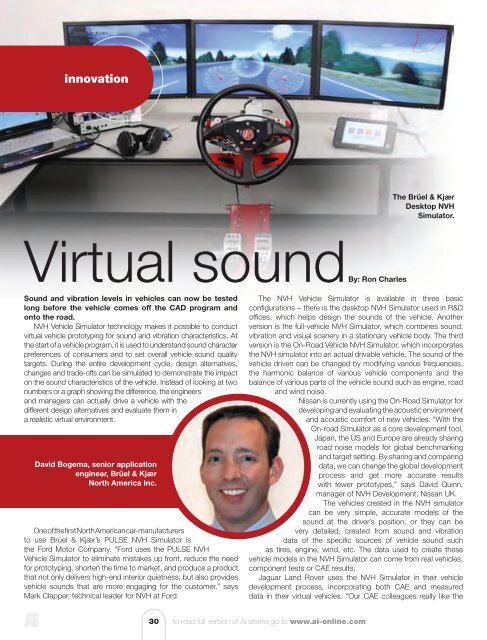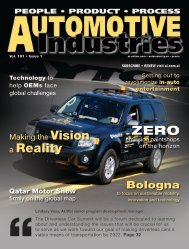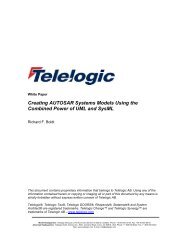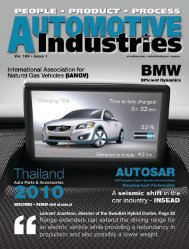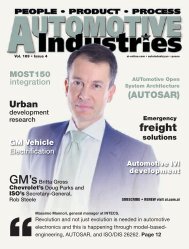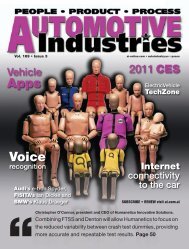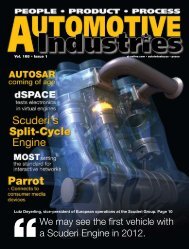Q2 2010 - Automotive Industries
Q2 2010 - Automotive Industries
Q2 2010 - Automotive Industries
Create successful ePaper yourself
Turn your PDF publications into a flip-book with our unique Google optimized e-Paper software.
innovation<br />
Virtual sound By: Ron Charles<br />
Sound and vibration levels in vehicles can now be tested<br />
long before the vehicle comes off the CAD program and<br />
onto the road.<br />
NVH Vehicle Simulator technology makes it possible to conduct<br />
virtual vehicle prototyping for sound and vibration characteristics. At<br />
the start of a vehicle program, it is used to understand sound character<br />
preferences of consumers and to set overall vehicle sound quality<br />
targets. During the entire development cycle, design alternatives,<br />
changes and trade-offs can be simulated to demonstrate the impact<br />
on the sound characteristics of the vehicle. Instead of looking at two<br />
numbers or a graph showing the difference, the engineers<br />
and managers can actually drive a vehicle with the<br />
different design alternatives and evaluate them in<br />
a realistic virtual environment.<br />
David Bogema, senior application<br />
engineer, Brüel & Kjær<br />
North America Inc.<br />
One of the first North American car-manufacturers<br />
to use Brüel & Kjær’s PULSE NVH Simulator is<br />
the Ford Motor Company. “Ford uses the PULSE NVH<br />
Vehicle Simulator to eliminate mistakes up front, reduce the need<br />
for prototyping, shorten the time to market, and produce a product<br />
that not only delivers high-end interior quietness, but also provides<br />
vehicle sounds that are more engaging for the customer,” says<br />
Mark Clapper, technical leader for NVH at Ford.<br />
The NVH Vehicle Simulator is available in three basic<br />
configurations – there is the desktop NVH Simulator used in R&D<br />
offices, which helps design the sounds of the vehicle. Another<br />
version is the full-vehicle NVH Simulator, which combines sound,<br />
vibration and visual scenery in a stationary vehicle body. The third<br />
version is the On-Road Vehicle NVH Simulator, which incorporates<br />
the NVH simulator into an actual drivable vehicle. The sound of the<br />
vehicle driven can be changed by modifying various frequencies,<br />
the harmonic balance of various vehicle components and the<br />
balance of various parts of the vehicle sound such as engine, road<br />
and wind noise.<br />
Nissan is currently using the On-Road Simulator for<br />
developing and evaluating the acoustic environment<br />
and acoustic comfort of new vehicles. “With the<br />
On-road Simulator as a core development tool,<br />
Japan, the US and Europe are already sharing<br />
road noise models for global benchmarking<br />
and target setting. By sharing and comparing<br />
data, we can change the global development<br />
process and get more accurate results<br />
with fewer prototypes,” says David Quinn,<br />
manager of NVH Development, Nissan UK.<br />
The vehicles created in the NVH simulator<br />
can be very simple, accurate models of the<br />
sound at the driver’s position; or they can be<br />
very detailed, created from sound and vibration<br />
data of the specific sources of vehicle sound such<br />
as tires, engine, wind, etc. The data used to create these<br />
vehicle models in the NVH Simulator can come from real vehicles,<br />
component tests or CAE results.<br />
Jaguar Land Rover uses the NVH Simulator in their vehicle<br />
development process, incorporating both CAE and measured<br />
data in their virtual vehicles. “Our CAE colleagues really like the<br />
30 to read full version of AI stories go to www.ai-online.com<br />
The Brüel & Kjær<br />
Desktop NVH<br />
Simulator.


